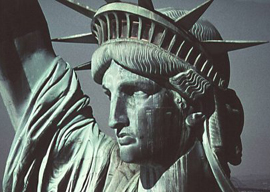
November 03, 2011

The refurbishing of the Statue of Liberty, which has been hoisting its torch above New York Harbor since October 1886, has evoked a torrent of lavishly tendentious praise in the national press. Perhaps the smuggest commentary is a New York Post op-ed piece by Terry Golway, director of the Kean University Center for History, Politics, and Policy.
Golway skimps on important historical facts. He might have offered other details about the statue—for example, that sculptor Frédéric Auguste Bartholdi also built the Eiffel Tower and that his work had been inspired by a radical Parisian law professor, Édouard René de Laboulaye, who had been an outspoken anti-monarchist and supporter of the Paris Commune in 1870. Laboulaye said he wished to have the statue constructed in 1865 to commemorate the Union victory in the Civil War and American slavery’s abolition. His heart’s desire was finally fulfilled when his disciple Bartholdi undertook the statue to celebrate the spiritual union of the US and France as pioneers in democratic revolutions.
Since the New York Post has been big on an American foreign policy based on a global human-rights mission, one might have thought it would commission a commentary on the statue highlighting the paper’s known liberal immigration politics with the stated purpose of the statue’s sculptor, which was to underline the universal nature of Franco-American revolutionary fervor.
Unfortunately Golway, who entitles his commentary “How the Lady lost her ‘Liberty,’” has other fish to fry—namely, the moral and ideological shortcomings of those who dedicated the statue in 1886. For all their revolutionary passion to spread liberty everywhere, Golway still finds fault:
These effusions were not without serious flaws. Black citizens of the United States might well have asked why liberty was denied them, not only in the South, but in every region of the nation. The French, for their part, were about to embark on a campaign of empire-building that would deny liberty to millions in Asia and Africa. Neither nation accorded women full rights—and full liberties.
By the end of Golway’s jeremiad, we learn that Lady Liberty’s builders and dedicators were not as concerned as he is about establishing a politically correct democracy. It took until 1903 before Emma Lazarus’s verse about the “huddled masses yearning to breathe free” was inscribed on the pedestal. Moreover, the Irish Catholic New York Mayor at the time, William R. Grace, “said nothing about his immigrant roots” when he addressed the crowd at what is now Liberty Island. For shame!
If Golway and this article’s neoconservative commissioners knew the full truth, they would be apopleptic. Emma Lazarus was not an unstinting immigration enthusiast. The descendant of an old New York Sephardic family, Miss Emma drew the line with German Jews, who might create problems if one tried to assimilate too many of them. This high-born lady was extremely discriminating about what “huddled masses” she’d allow in the country.